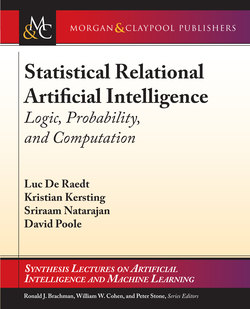Читать книгу Statistical Relational Artificial Intelligence - Luc De Raedt - Страница 7
На сайте Литреса книга снята с продажи.
ОглавлениеContents
Preface
1 Motivation
1.1 Uncertainty in Complex Worlds
1.2 Challenges of Understanding StarAI
1.3 The Benefits of Mastering StarAI
1.4 Applications of StarAI
1.5 Brief Historical Overview
PART I Representations
2 Statistical and Relational AI Representations
2.1 Probabilistic Graphical Models
2.1.1 Bayesian Networks
2.1.2 Markov Networks and Factor Graphs
2.2 First-Order Logic and Logic Programming
3 Relational Probabilistic Representations
3.1 A General View: Parameterized Probabilistic Models
3.2 Two Example Representations: Markov Logic And ProbLog
3.2.1 Undirected Relational Model: Markov Logic
3.2.2 Directed Relational Models: ProbLog
4 Representational Issues
4.1 Knowledge Representation Formalisms
4.2 Objectives for Representation Language
4.3 Directed vs. Undirected models
4.4 First-Order Logic vs. Logic Programs
4.5 Factors and Formulae
4.6 Parameterizing Atoms
4.7 Aggregators and Combining Rules
4.8 Open Universe Models
4.8.1 Identity Uncertainty
4.8.2 Existence Uncertainty
4.8.3 Ontologies
PART II Inference
5 Inference in Propositional Models
5.1 Probabilistic Inference
5.1.1 Variable Elimination
5.1.2 Recursive Conditioning
5.1.3 Belief Propagation
5.2 Logical Inference
5.2.1 Propositional Logic, Satisfiability, and Weighted Model Counting
5.2.2 Semiring Inference
5.2.3 The Least Herbrand Model
5.2.4 Grounding
5.2.5 Proving
6 Inference in Relational Probabilistic Models
6.1 Grounded Inference for Relational Probabilistic Models
6.1.1 Weighted Model Counting
6.1.2 WMC for Markov Logic
6.1.3 WMC for ProbLog
6.1.4 Knowledge Compilation
6.2 Lifted Inference: Exploiting Symmetries
6.2.1 Exact Lifted Inference
6.3 (Lifted) Approximate Inference
PART III Learning
7 Learning Probabilistic and Logical Models
7.1 Learning Probabilistic Models
7.1.1 Fully Observed Data and Known Structure
7.1.2 Partially Observed Data with Known Structure
7.1.3 Unknown Structure and Parameters
7.2 Logical and Relational Learning
7.2.1 Two Learning Settings
7.2.2 The Search Space
7.2.3 Two Algorithms: Clausal Discovery and FOIL
7.2.4 From Propositional to First-Order Logic
7.2.5 An ILP Example
8 Learning Probabilistic Relational Models
8.1 Learning as Inference
8.2 The Learning Problem
8.2.1 The Data Used
8.3 Parameter Learning of Relational Models
8.3.1 Fully Observable Data
8.3.2 Partially Observed Data
8.3.3 Learning with Latent Variables
8.4 Structure Learning of Probabilistic Relational Models
8.4.1 A Vanilla Structure Learning Approach
8.4.2 Probabilistic Relational Models
8.4.3 Boosting
8.5 Bayesian Learning
PART IV Beyond Probabilities
9 Beyond Basic Probabilistic Inference and Learning
9.1 Lifted Satisfiability
9.2 Acting in Noisy Relational Worlds
9.3 Relational Optimization
10 Conclusions
Bibliography
Authors’ Biographies
Index
